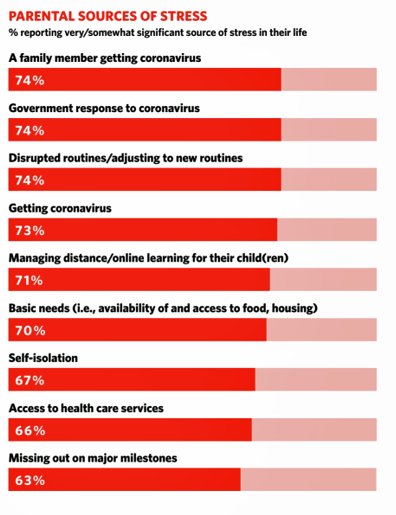“The COVID-19 pandemic has altered every aspect of American life, from health and work to education and exercise,” the new Stress in America 2020 study from the American Psychological Association begins.
 The APA summarizes the impact of these mass changes on the nation: “The negative mental health effects of the coronavirus may be as serious as the physical health implications,” with COVID-19 stressors hitting all health citizens in the U.S. in different ways.
The APA summarizes the impact of these mass changes on the nation: “The negative mental health effects of the coronavirus may be as serious as the physical health implications,” with COVID-19 stressors hitting all health citizens in the U.S. in different ways.
Beyond the risk of contracting the virus, the Great Lockdown of the U.S. economy has stressed the U.S. worker and the national economy, with 7 in 10 employed people saying work is a significant source of stress in their lives, up from 64% of workers in 2019. Seven in 10 U.S. workers also say that the economy is a significant stress for them, up from 46% in August 2019.
Americans are also stressed by the U.S. government’s response to the coronavirus pandemic. Seven in 10 U.S. adults told the APA that the government response to COVID-19 is a significant source of stress, with majorities across political party feeling that major stressor:
- 73% of Democrats say the government response to COVID-19 is a significant source of stress, as well as
- 67% of Independents, and
- 63% of Republicans.

Furthermore, regionally, at least 6 in 10 Americans find the government response to COVID-19 a significant stressor, including:
- 64% in the West
- 65% in the South
- 70% in the Northeast, and
- 70% in the Midwest.
APA also examined differences in stress between parents and non-parents. Parents’ stress levels due to COVID-19 were greater: the average stress level for U.S. adults was 5.4, and for parents in the U.S., 6.7.
Parents’ stress due to COVID-19 is greater across many life dimensions: the added stress of managing social distancing and teleworking, which is a major life adjustment for a working person shifting a workspace from a more social and organized office setting to working alone at a kitchen table — then, managing children’s schedules, schooling, and socialization on top of one’s own adjustments.
 The bar chart details parental sources of stress in the age of COVID-19. Majorities of parents report significant sources of stress concerned about a family member getting the virus, the government response to COVID-19 (greater than for parents than non-parents), disrupting routines and adjusting to new ones, getting the coronavirus themselves, managing home schooling for children, basic needs (the social determinants of health like food and housing security), self-isolation, access to health care, and missing out on major milestones.
The bar chart details parental sources of stress in the age of COVID-19. Majorities of parents report significant sources of stress concerned about a family member getting the virus, the government response to COVID-19 (greater than for parents than non-parents), disrupting routines and adjusting to new ones, getting the coronavirus themselves, managing home schooling for children, basic needs (the social determinants of health like food and housing security), self-isolation, access to health care, and missing out on major milestones.
Finally, as with the impact of the coronavirus on people of color, pandemic-related stress may have a disproportionate effect on communities of color, APA notes in the report. More than 2 in 5 Hispanic people (41%) reported average stress levels ranging between 8 and the high of 10.
People of color more than white adults are more likely to report significant stressors in daily life resulting from COVID-19, especially worried about contracting the coronavirus, supplying basic needs for themselves and their families, and accessing health care.
The Harris Poll conducted the Stress in America 2020 survey online among 3,013 U.S. adults 18 and over from April 24 to May 4, 2020.
Health Populi’s Hot Points: Today 21st May the Bureau of Labor Statistics reports an additional 2.4 million Americans filed for State unemployment benefits last week. This totals State unemployment benefits claims reaching 39 million in nine weeks as the coronavirus pandemic emerged in the U.S. Note that this total jobs lost number does not include workers in the gig economy who could file for Pandemic Unemployment Assistance, so well over 40 million people in America have lost jobs in the pandemic era to-date.
Federal Reserve Chairman Jerome Powell spoke earlier this week about the prospects for U.S. economic growth in 2020 and into 2021. He soberly forecasted that an economic recovery could “stretch” to the end of 2021. A new report from the Congressional Budget Office also forecasts a slow post-COVID-19 economic recover.
The stressors of COVID-19 will last long after a vaccine could be marketed in early 2021, which is an optimistic projection of just when that solution to the virus could occur. In the meantime, the mental health aspects will be the pandemic long after the pandemic, acutely impacting parents, children, and people of color disproportionately.
